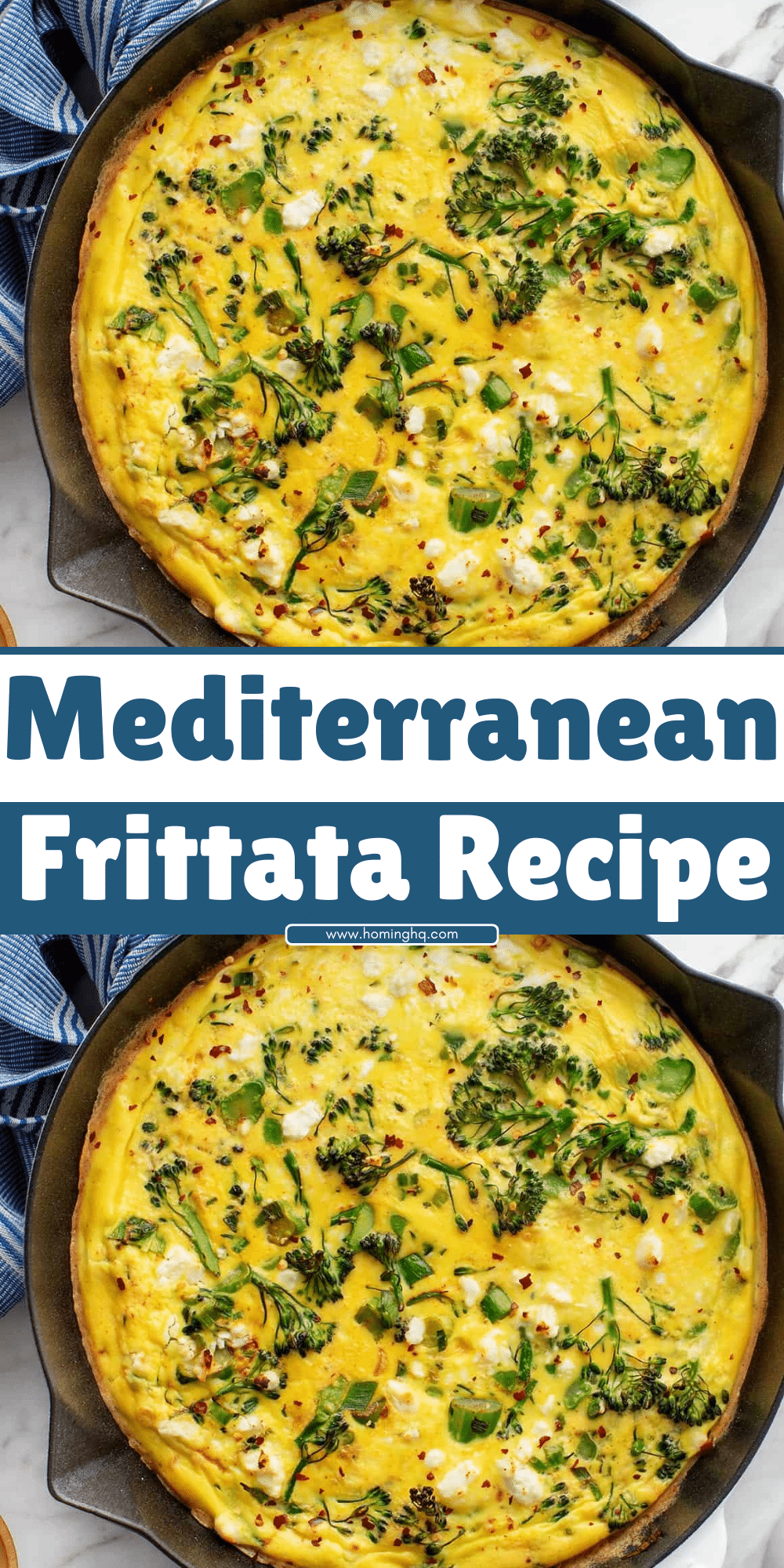All products are selected by our editorial team for quality. If you buy through our links, we may earn a small commission at no extra cost to you.
If you’re craving a hearty, flavorful meal that’s as versatile as it is delicious, look no further than a Mediterranean Frittata.
This dish combines the best of Mediterranean cuisine with the comfort of a classic frittata, creating a dish that’s perfect for breakfast, brunch, lunch, or even dinner.
Loaded with vibrant vegetables, aromatic herbs, and tangy cheeses, a Mediterranean Frittata is not just satisfying but also packed with nutrients.
Whether you’re looking to start your day on a healthy note or impress your guests with a savory dish, this Mediterranean twist on the classic frittata will quickly become a go-to recipe in your kitchen.

What is a Frittata?
A frittata is an Italian-style omelette that’s made with eggs, vegetables, and sometimes meat or cheese.
Unlike an omelette, which is folded over its filling, a frittata is typically cooked slowly and finished in the oven, resulting in a thicker, more substantial texture.
The beauty of a frittata lies in its versatility – you can add almost anything to the eggs, from leftover vegetables to a variety of cheeses and meats, making it a great way to use up ingredients while creating a satisfying meal.
Unlike quiche, a frittata does not have a crust, which makes it lighter and quicker to prepare.
It can be served hot, warm, or even at room temperature, which makes it a fantastic option for gatherings or meal prep.
When it comes to a Mediterranean Frittata, the addition of ingredients like tomatoes, spinach, olives, and feta cheese brings the flavors of the Mediterranean directly to your plate in a way that feels both fresh and indulgent.
Key Ingredients for Mediterranean Frittata
A Mediterranean Frittata is all about fresh, vibrant ingredients that bring out the best of Mediterranean cuisine.
Here’s a look at the key elements that make this dish both delicious and nutritious:
Eggs: The Foundation of the Dish
At the heart of every frittata are eggs, which provide structure and richness.
For the best results, use large eggs to create a light, fluffy texture.
You can even use egg whites for a lighter version or opt for omega-3 enriched eggs for an added nutritional boost.
Mediterranean Vegetables
Fresh vegetables are a hallmark of Mediterranean cuisine, and in this frittata, they take center stage.
A combination of sautéed tomatoes, bell peppers, onions, and spinach will add color, flavor, and texture.
Feel free to mix in other Mediterranean staples like zucchini or roasted eggplant to customize the dish.
Cheese Options
A key ingredient in a Mediterranean Frittata is cheese, which adds creaminess and depth of flavor.
Feta cheese is a classic choice, offering a tangy, crumbly texture that pairs beautifully with the vegetables.
Alternatively, goat cheese or Parmesan can be used for a slightly different flavor profile.
For an even richer taste, a blend of these cheeses can be added.
Herbs and Seasonings
To capture the essence of the Mediterranean, a variety of herbs and seasonings are used.
Dried oregano, fresh basil, and a touch of garlic bring the dish to life, infusing each bite with an aromatic kick.
A pinch of salt and pepper helps bring all the flavors together, enhancing the natural tastes of the vegetables and eggs.
Protein Additions (Optional)
While the frittata is delicious on its own, you can also add protein to make it more filling.
Olives, sun-dried tomatoes, and even cooked chicken or lamb are excellent Mediterranean-inspired options.
These ingredients complement the eggs and vegetables, adding an extra layer of flavor and texture to the dish.
By combining these ingredients, you’ll create a Mediterranean Frittata that’s not only packed with flavor but also brimming with nutrients, making it a wholesome and satisfying meal any time of day.
How to Make Mediterranean Frittata: Step-by-Step

Making a Mediterranean Frittata is simple and straightforward, but the result is nothing short of spectacular.
Follow these step-by-step instructions to create a dish that’s bursting with flavor.
Step 1: Prepare the Ingredients
Start by prepping your vegetables and protein. Dice the tomatoes, bell peppers, and onions into bite-sized pieces.
Wash and roughly chop the spinach or other leafy greens.
If you’re using olives, sun-dried tomatoes, or cooked meat, chop those as well.
Grate or crumble your cheese—Feta is the most common choice, but goat cheese or Parmesan works well too.
Step 2: Sauté the Vegetables
Heat a tablespoon of olive oil in a large oven-safe skillet over medium heat.
Once the oil is hot, add the diced onions and bell peppers.
Sauté for 3-4 minutes until they start to soften, then add the chopped tomatoes.
Cook for another 3-4 minutes until the tomatoes begin to break down and release their juices.
Add the spinach and sauté for 1-2 minutes until wilted. Season with salt, pepper, and dried oregano. Set the sautéed vegetables aside.
Step 3: Mix the Eggs and Seasoning
In a large mixing bowl, crack 8 large eggs (or the desired amount for your skillet) and beat them together with a fork or whisk.
Add salt, pepper, and fresh basil.
If you prefer a richer flavor, you can mix in a splash of milk or cream, but this is optional.
Once well-beaten, stir in half of your grated or crumbled cheese.
Step 4: Combine and Cook
Pour the egg mixture over the sautéed vegetables in the skillet. Stir gently to ensure everything is evenly distributed.
Let the mixture cook over medium-low heat for 3-4 minutes, just until the edges begin to set.
Then, place the skillet in a preheated oven at 375°F (190°C) and bake for about 10-12 minutes, or until the center is set and the top is lightly golden.
Step 5: Garnish and Serve
Once the frittata is cooked, remove it from the oven and allow it to cool for a minute.
Garnish with extra crumbled cheese, fresh herbs like basil or parsley, and a drizzle of olive oil for added richness.
Slice into wedges and serve warm or at room temperature.
Tips and Tricks for the Perfect Mediterranean Frittata
While making a Mediterranean Frittata is easy, there are a few tips and tricks to help you elevate the dish and ensure it turns out perfectly every time.
Customizing Your Frittata
One of the best things about a frittata is its versatility.
You can customize it with different vegetables, cheeses, or proteins based on what you have available.
Try adding roasted eggplant, zucchini, or even artichokes for a Mediterranean twist.
If you’re a fan of seafood, consider incorporating shrimp or salmon for added richness.
Avoid Overcooking the Eggs
To achieve the perfect frittata, it’s important not to overcook the eggs. They should be set but still slightly creamy in the center.
If you leave it in the oven too long, it can become dry and rubbery.
Keep an eye on the frittata during the last few minutes of baking to ensure the center is just firm enough but not overdone.
Use a Nonstick or Well-Seasoned Skillet
Since frittatas are often finished in the oven, it’s essential to use an oven-safe skillet.
A nonstick skillet or a well-seasoned cast-iron pan makes it easier to slide the frittata out of the pan after cooking, preventing it from sticking to the sides.
Layer Flavors for Maximum Impact
Mediterranean cuisine is all about layering flavors.
Start with sautéed vegetables, add in some fresh herbs, and finish with a sprinkle of cheese or olives.
This creates a balanced dish with each bite offering something new, from the savory vegetables to the creamy cheese and aromatic herbs.
Let It Rest Before Serving
Allow the frittata to rest for a minute or two after taking it out of the oven. This helps it firm up slightly, making it easier to slice and serve.
A frittata can also be served at room temperature, which makes it perfect for meal prep or a relaxed brunch.
By following these tips, you’ll ensure that your Mediterranean Frittata comes out fluffy, flavorful, and ready to impress anyone who tastes it!
Conclusion
A Mediterranean Frittata is the perfect dish for anyone who loves bold flavors and fresh ingredients.
With its versatile combination of eggs, vegetables, cheeses, and Mediterranean-inspired herbs, this frittata is a meal that’s both satisfying and nutritious.
Whether you enjoy it for breakfast, lunch, or dinner, this recipe is quick, customizable, and ideal for any occasion.
Plus, it’s an excellent option for meal prep, as it stores well and can be enjoyed warm or at room temperature.
By following the simple steps and incorporating your favorite Mediterranean ingredients, you’ll be able to enjoy a delicious frittata that’s bursting with flavor and perfect for any time of day.
Get creative with your additions, make it your own, and share it with friends and family for a memorable meal that everyone will love!
Frequently Asked Questions
1. Can I make a Mediterranean Frittata ahead of time?
Absolutely! You can make the frittata ahead of time and store it in the fridge for up to 3 days.
Simply reheat it in the oven at a low temperature (about 300°F/150°C) until warm. It also makes for a great meal prep option.
2. Can I freeze a Mediterranean Frittata?
Yes, you can freeze the frittata. Once it’s fully cooled, wrap it tightly in plastic wrap or aluminum foil and place it in an airtight container or freezer bag.
It can be frozen for up to 2 months. To reheat, thaw it in the fridge overnight and bake at 350°F (175°C) until heated through.
3. What are some good variations for a Mediterranean Frittata?
You can customize your Mediterranean Frittata by adding ingredients like roasted eggplant, zucchini, or artichokes for extra flavor.
If you prefer a meatier option, try adding grilled chicken, lamb, or even seafood like shrimp.
For a vegan version, use tofu or chickpea flour as a substitute for eggs.
4. How do I know when the frittata is done?
The frittata is done when the center is fully set and no longer jiggly, but still slightly creamy.
You can check for doneness by gently shaking the skillet; if the center is firm and the top is lightly golden, it’s ready to come out of the oven.
5. Can I make this frittata in a different type of pan?
Yes, you can use any oven-safe skillet or baking dish. A 9-inch (23 cm) round or square pan works perfectly for this recipe.
Just make sure the pan is oven-safe and you adjust the cooking time if necessary depending on the size of your pan.

Mediterranean Frittata
Equipment
- 1 Oven-safe skillet (10-inch or larger)
- 1 Whisk or fork
- 1 Cutting Board
- 1 Sharp knife
- 1 measuring spoons
- 1 Mixing bowl
- 1 Grater (for cheese)
- Oven preheated to 375°F (190°C)
Ingredients
- 8 large eggs
- 1 tablespoon olive oil
- 1 small onion diced
- 1 red bell pepper diced
- 1 large tomato diced
- 2 cups fresh spinach chopped
- ½ cup feta cheese crumbled (or goat cheese, optional)
- 1 teaspoon dried oregano
- 1 teaspoon fresh basil chopped
- Salt and pepper to taste
- Optional: ½ cup olives or sun-dried tomatoes chopped
Instructions
- Preheat your oven to 375°F (190°C).
- Prepare your vegetables: Dice the onion, bell pepper, and tomato. Chop the spinach roughly. If using olives or sun-dried tomatoes, chop them as well.
- Sauté the vegetables: In an oven-safe skillet, heat olive oil over medium heat. Add diced onion and bell pepper, cooking for 3-4 minutes until softened. Add the tomato and spinach, cooking for another 2-3 minutes until the spinach wilts.
- Prepare the egg mixture: In a large mixing bowl, crack the eggs and whisk together. Add salt, pepper, oregano, and fresh basil. Stir in the crumbled feta cheese.
- Combine eggs and vegetables: Pour the egg mixture over the sautéed vegetables in the skillet. Stir gently to combine. Let the frittata cook for 2-3 minutes on the stove until the edges start to set.
- Bake: Transfer the skillet to the oven and bake for 10-12 minutes, or until the frittata is fully set in the center and lightly golden on top.
- Serve: Remove from the oven, garnish with additional fresh herbs or crumbled cheese, and slice into wedges. Serve warm or at room temperature.
Notes
- Customizations: Feel free to swap out vegetables based on your preferences or what’s in season—zucchini, roasted eggplant, or artichokes would be great additions.
- Cheese Substitutes: If you don’t have feta, goat cheese or Parmesan can work beautifully, though the flavor will vary slightly.
- Storage: This frittata stores well in the fridge for 2-3 days and can be eaten cold or reheated in the oven or microwave.
- Make It Vegan: To make this recipe vegan, substitute eggs with a chickpea flour mixture (1 cup chickpea flour + 1 cup water) and use vegan cheese or omit the cheese entirely.

